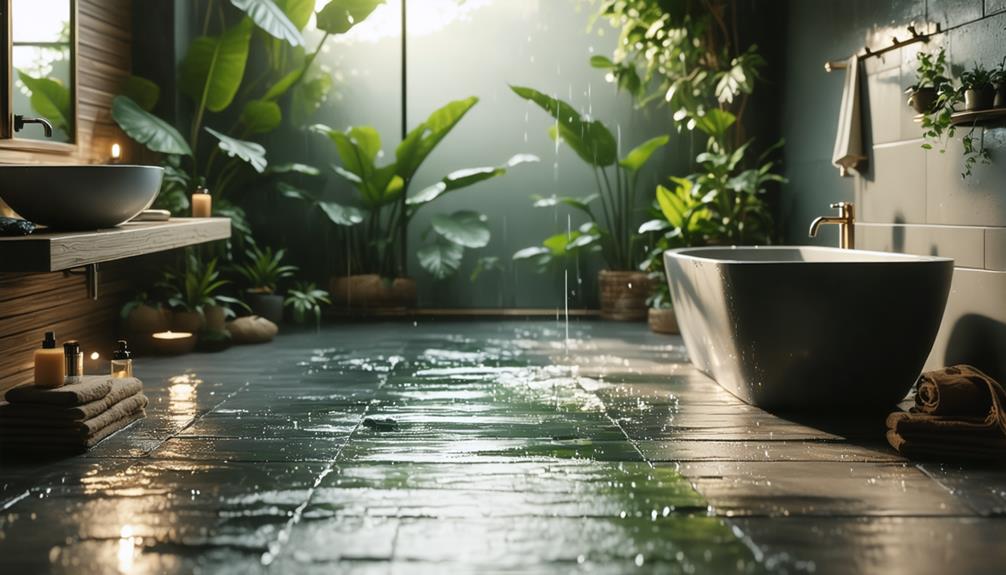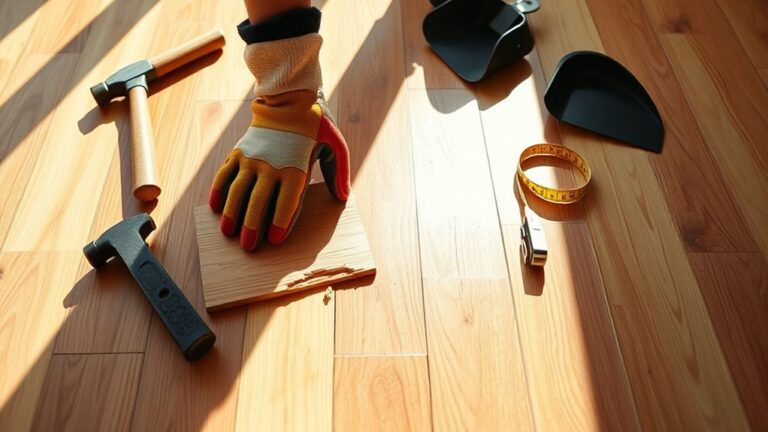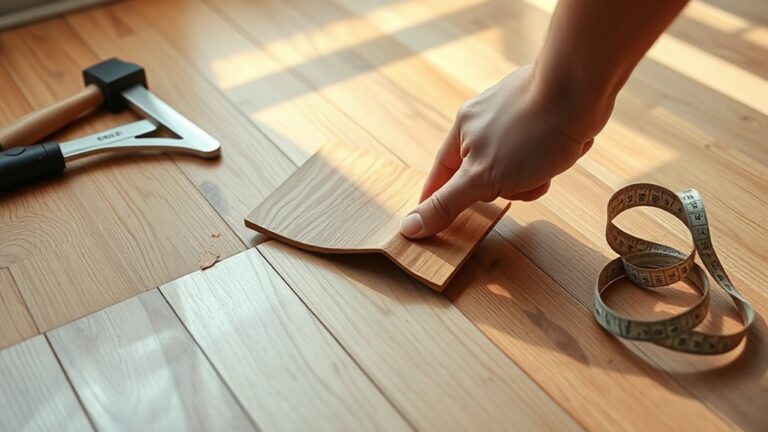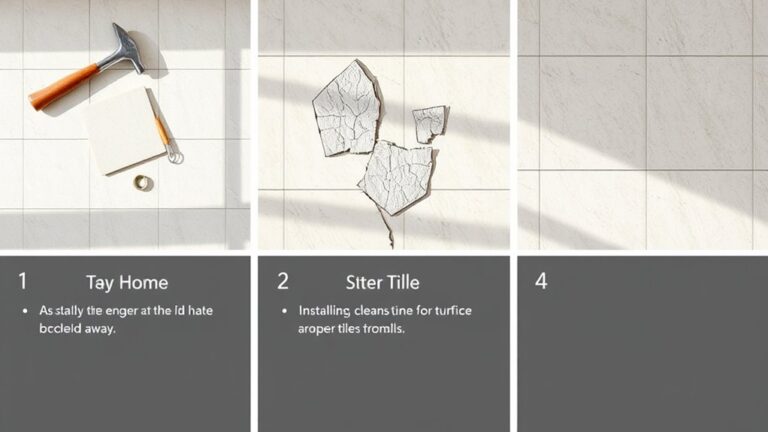When choosing flooring for high-moisture areas, prioritize waterproof options like vinyl or porcelain tiles. Vinyl is budget-friendly, 100% waterproof, and easy to maintain, while porcelain boasts low water absorption and is resistant to staining. Avoid solid hardwood, as it's susceptible to warping; instead, consider engineered wood for better moisture resistance. Guarantee proper installation with a moisture barrier and follow maintenance routines to prevent mold buildup. Keep an eye on costs, as vinyl starts around $2 per square foot, whereas porcelain can range higher. You'll discover even more tips and insights to make the best choice for your space.
Understanding Flooring Types
When selecting flooring for high-moisture areas, understanding the distinction between waterproof and water-resistant options is essential. Waterproof flooring is engineered to withstand substantial spills and high moisture without incurring damage, whereas water-resistant flooring can handle minimal moisture but risks warping or splitting if spills aren't promptly cleaned up.
Vinyl flooring emerges as a top contender for these environments. Its synthetic material not only resists moisture but is also incredibly easy to clean, making it both a budget-friendly and efficient choice for installation. If you're looking for a more luxurious feel, ceramic and porcelain tiles are excellent options. They offer durability and aesthetic appeal, with porcelain tiles providing slightly superior waterproof properties compared to ceramic.
While hardwood flooring is a popular choice, it poses significant risks in wet areas due to its susceptibility to warping and splitting when exposed to moisture. If hardwood is a must, consider engineered wood as a more stable alternative, though it still has limitations in high-moisture settings. On the other hand, laminate flooring generally isn't recommended for these locations, as it can easily warp and sustain damage from water exposure.
Ultimately, choosing the right flooring type hinges on your specific needs and the level of moisture exposure in your space. Prioritizing waterproof options like vinyl or tile will grant you peace of mind and long-lasting performance in your high-moisture areas.
Best Waterproof Flooring Options
When selecting flooring for high-moisture areas, you'll want options that combine durability and water resistance. Vinyl flooring offers a cost-effective solution with impressive scratch resistance, while porcelain tile provides unparalleled durability and style. Additionally, waterproof engineered hardwood can give you the aesthetic of natural wood without the worry of water damage, making it a great choice for these environments.
Vinyl Flooring Benefits
Although many flooring options struggle in high-moisture environments, vinyl flooring stands out as the premier choice for areas like bathrooms and laundry rooms due to its 100% waterproof nature. This characteristic effectively prevents moisture damage, ensuring your floors remain in top condition even in high-traffic wet areas.
One of the key benefits of vinyl flooring is its impressive durability. High-quality vinyl features thick wear layers that resist scratches and dents, making it ideal for busy households. Additionally, vinyl sheet flooring is particularly beneficial, as its minimal seams further inhibit moisture infiltration, perfect for expansive spaces susceptible to humidity.
Aesthetically, vinyl flooring offers a wide variety of colors, designs, and patterns, allowing you to achieve your desired look while maintaining functionality. You'll appreciate how easy to clean vinyl flooring is—just a damp mop is sufficient for upkeep. This ease of maintenance not only saves you time but also promotes a hygienic environment, resisting mold and mildew growth.
In short, if you're seeking a stylish, durable, and practical flooring solution for high-moisture areas, vinyl flooring is your best bet.
Porcelain Tile Advantages
For those looking for a reliable flooring solution in high-moisture areas, porcelain tile offers exceptional advantages that make it a top contender. Its low water absorption rate of 0.5% or less guarantees that moisture won't be a problem in environments like bathrooms and laundry rooms. Plus, you'll appreciate its durability; porcelain tile is resistant to warping, scratching, and staining, making it a long-lasting choice for your home.
Here are some key advantages of choosing porcelain tile:
- Superior Waterproofing Capabilities: Fired at higher temperatures, porcelain is denser than ceramic, providing unmatched moisture resistance.
- Durable Option: With proper maintenance, this flooring can withstand the test of time, making it a smart investment.
- Variety of Designs: You can achieve the aesthetic you desire with a wide range of colors and finishes.
- Easy to Clean: The smooth surface requires minimal effort; regular mopping is all it takes to maintain its pristine appearance.
Choosing porcelain tile means embracing a flooring solution that combines beauty, functionality, and resilience tailored for high-moisture areas.
Waterproof Engineered Hardwood
Waterproof engineered hardwood presents a sophisticated flooring solution that combines the natural beauty of wood with enhanced moisture resistance. With its multi-layer construction and real wood veneer finish, this flooring is specifically designed for high humidity environments, minimizing issues like expansion and contraction that often plague solid hardwood.
| Feature | Waterproof Engineered Hardwood | Solid Hardwood |
|---|---|---|
| Moisture Resistance | High | Low |
| Cost Per Square Foot | $4 – $10 | $8 – $15 |
| Sanding/Refinishing Options | No | Yes |
This flooring option is ideal for areas where humidity levels exceed 50%, offering a cost-effective option without sacrificing aesthetic appeal. The pressed layers, with alternating grain directions, provide superior stability, effectively reducing the risk of warping and damage. While it can't be sanded or refinished, its durability in high-moisture settings makes it a practical choice for your home.
Choosing waterproof engineered hardwood means you can enjoy the elegance of wood while ensuring your flooring withstands the challenges of moisture, allowing you the freedom to live in comfort.
Pros and Cons of Flooring Materials
When selecting flooring for high-moisture areas, it's crucial to weigh the pros and cons of various materials. Each flooring type offers its unique benefits and drawbacks that can impact your decision. Here's a breakdown of some popular options:
- Vinyl Flooring: This is highly versatile and completely waterproof, making it easy to install and maintain. It's an affordable choice, starting around $2 per square foot, perfect for those on a budget.
- Ceramic Tile: Known for its luxurious look and excellent water resistance, ceramic tile can elevate the aesthetic of your space. However, installation can be challenging, and costs range from $12 to $45 per square foot.
- Engineered Wood Flooring: More moisture-resistant than traditional hardwood, this option features a real wood veneer but can't be sanded or refinished. It typically costs between $4 to $10 per square foot, balancing aesthetics and practicality.
- Laminate Flooring: While generally affordable at $1 to $3 per square foot, traditional laminate doesn't hold up well in high-moisture environments. It can swell and blister, making it less suitable compared to waterproof alternatives.
Choosing the right flooring involves considering these pros and cons. You want a material that not only suits your design preferences but also stands up to the challenges of high-moisture areas. Prioritize durability and water resistance to guarantee your investment pays off in the long run.
Installation Considerations for Wet Areas
Installing flooring in wet areas requires careful attention to detail to guarantee long-lasting performance and prevent moisture-related issues. To achieve a successful installation, consider these key factors:
| Installation Consideration | Importance |
|---|---|
| Subfloor Preparation | Make certain it's clean, dry, and level to avoid moisture issues. |
| Moisture Barrier Underlayment | Protects the subfloor and enhances comfort and insulation. |
| Water-Resistant Grout | Minimizes water infiltration in tile installations. |
| Appropriate Expansion Gaps | Allows for humidity and temperature changes, preventing warping. |
First and foremost, proper subfloor preparation is vital. Taking the time to clean, dry, and level the surface before installation can save you from significant headaches down the line. Next, incorporating a moisture barrier underlayment is necessary in wet areas. It not only protects your subfloor but also adds comfort and insulation.
If you're choosing tile, selecting water-resistant grout is a must to minimize water infiltration over time. Additionally, always maintain appropriate expansion gaps around your flooring materials. This simple step accommodates changes in humidity and temperature, preventing warping and buckling.
Maintenance Tips for High-Moisture Floors
To keep your high-moisture floors in top condition, establishing a regular cleaning routine is essential. Use a damp mop with a mild cleaner to effectively prevent mold and mildew buildup. Additionally, don't forget to seal porous materials periodically to enhance their water resistance and extend their lifespan.
Regular Cleaning Routine
Maintaining high-moisture floors requires a diligent cleaning routine to prevent mold growth and guarantee longevity. To keep your tiles and vinyl flooring in prime condition, it is crucial to implement a systematic approach to cleaning. Here are some key maintenance tips to bear in mind:
- Sweep or vacuum regularly: Remove dirt and debris that can trap moisture and encourage mold growth.
- Mop with care: Use a damp mop and a mild detergent designed for your specific flooring type to clean effectively without leaving excess water.
- Utilize a squeegee: After mopping or spills, quickly remove standing water to prevent moisture buildup on your tiles and vinyl surfaces.
- Inspect for damage: Regularly check for leaks or signs of damage, addressing any issues promptly to avoid further moisture-related problems.
Proper Sealing Techniques
Proper sealing techniques are vital for protecting high-moisture floors from water damage and mold growth. Start by regularly applying a high-quality sealant to porous flooring materials such as grout and natural stone. This prevents moisture infiltration that can lead to mold and mildew. During installation, verify that all seams in vinyl and laminate flooring are properly sealed; this minimizes the risk of moisture seeping through.
It's essential to inspect and reapply sealants as needed, typically every 1-3 years. Follow the manufacturer's recommendations and consider the level of foot traffic in the area. For tiled surfaces, utilize water-resistant grout to enhance moisture protection. This further reduces the potential for mold and mildew, keeping your floors safe and looking great.
After cleaning, always verify that surfaces are completely dry before reapplying sealants. Trapping moisture underneath can lead to further damage and negate the benefits of your sealing efforts. By implementing these proper sealing techniques, you'll maintain the integrity of your high-moisture floors, providing you with a safe, beautiful, and worry-free environment for years to come.
Cost Analysis of Flooring Choices
When considering flooring for high-moisture areas, it's crucial to evaluate the costs associated with various options. A thorough cost analysis will help you make informed decisions while balancing your budget and aesthetic preferences. Here's a breakdown of some popular flooring options:
- Vinyl Flooring: Typically ranges from $2 to $5 per square foot, making it a cost-effective choice for areas like bathrooms and kitchens.
- Ceramic and Porcelain Tiles: Generally cost between $5 and $15 per square foot, with installation fees that can vary dramatically from $9 to $50 per square foot based on complexity.
- Engineered Hardwood: This offers moisture resistance at around $4 to $10 per square foot, providing a more budget-friendly alternative to solid hardwood.
- Water-Resistant Laminate: Available for $1 to $3 per square foot, but it's best to avoid using it in high-moisture environments.
Don't forget the additional costs of professional installation, which can add $2 to $5 per square foot to your overall budget. While DIY installation is tempting, professional help can guarantee a proper fit and finish, especially in tricky moisture-prone areas. By weighing these flooring options and their respective costs, you can confidently choose a solution that meets both your functional needs and your financial constraints. Remember, investing wisely in flooring can save you from future issues related to water damage and maintenance.
Safety Features for Wet Environments
Choosing the right flooring for high-moisture areas not only involves cost considerations but also safety features that greatly impact your living space. In environments where water is prevalent, prioritizing slip resistance is essential. You should look for flooring options with textured surfaces or certified slip-resistant ratings to minimize fall hazards. Waterproof flooring is another critical aspect, as it helps prevent mold growth and structural damage, reducing health risks associated with damp conditions.
To enhance safety further, guarantee that your wet areas are well-lit. Adequate lighting improves visibility, allowing you to identify potential hazards on the floor more easily. Regular inspections for cracks or damage in your flooring will also play a significant role in preventing slips and falls, ensuring a safer living space.
Here's a quick reference table to summarize key safety features for wet environments:
| Safety Feature | Importance |
|---|---|
| Slip Resistance | Minimizes fall hazards; essential for wet floors. |
| Waterproof Flooring | Prevents mold growth; reduces health risks. |
| Regular Inspections | Identifies damage; maintains overall safety. |
Additionally, don't forget about establishing emergency preparedness plans for water-related incidents like flooding. This proactive approach enhances safety and reduces damage risks, allowing you to enjoy your space with peace of mind. By focusing on these safety features, you'll create a more secure environment in your high-moisture areas.
Frequently Asked Questions
What Is the Best Flooring for High Moisture Area?
When it comes to flooring for high moisture areas, you've got several water-resistant options to evaluate. Look into porcelain or ceramic tiles for durability and style. For ease of installation, luxury vinyl planks are a fantastic choice. Don't forget to weigh cost considerations; sheet vinyl can be budget-friendly. Regular maintenance practices like sealing grout can extend the life of your flooring, while also allowing for aesthetic choices that match your personal taste.
What Is the Best Flooring for Damp Areas?
Imagine your home as a ship maneuvering through a storm; choosing water-resistant options is your best defense. For damp areas, consider porcelain tile or waterproof vinyl. Pay attention to installation tips, ensuring proper underlayment to keep moisture at bay. Maintenance strategies like regular cleaning will preserve aesthetics, while cost considerations shouldn't be overlooked. Ultimately, you deserve a flooring choice that harmonizes beauty and functionality, giving you the freedom to thrive in any environment.
What Is the Best Flooring Material for Wet Areas?
When considering the best flooring material for wet areas, you'll want to explore water resistant options like porcelain tile, luxury vinyl, or sheet vinyl. Each offers unique aesthetic choices to fit your style. For installation, guarantee proper subfloor preparation to prevent moisture issues. Maintenance practices are vital; regular cleaning keeps surfaces safe. Also, factor in budget considerations, as some materials may require a higher initial investment but offer long-term durability and performance.
What Is the Best Subfloor for High Moisture Areas?
You'd think any subfloor would work fine, but in high-moisture areas, that's a risky gamble. Opt for moisture-resistant subfloor materials like treated plywood or concrete slabs. Incorporate moisture barriers during installation to keep dampness at bay. Regular maintenance tips include checking for leaks and ensuring proper sealing. While costs vary, investing in durable materials saves you from future headaches. So, choose wisely to embrace that freedom from constant repairs!




